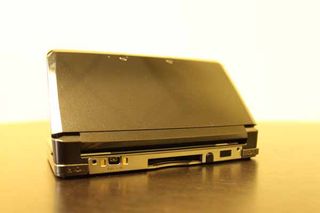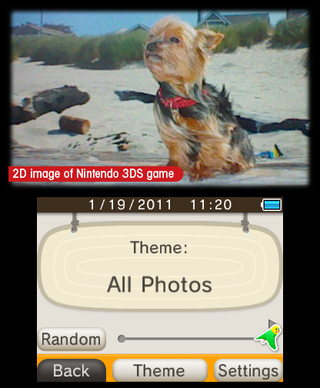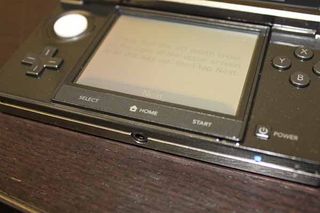Nintendo 3DS: Futuristic Handheld, Retro Battery
The Nintendo 3DS launches in North America on March 27th. Is this new glasses-free 3D goodness worth your hard-earned $250?
The Hardware

Let’s not beat around the bush here: Even with the 3D screen switched off, the 3DS is not an incremental update in the DS line of handhelds. This is thanks to the new hardware under the hood, which Nintendo has yet to officially reveal to the world. We know there is a 200 MHz-400 MHz DMP PICA200 graphics processor in the 3DS, but the CPU is a big question mark. Based on rumors over the last several months, the 3DS might be packing dual ARM 11 chips, with each running at 266 MHz. That’s twice as fast as the DSi, and over quadruple the speed of the DS and DS Lite.

Regardless of what actually lies within, gameplay on the 3DS is extremely smooth in most cases. The only time the framerate tends to drop is when Augmented Reality comes into play. When playing Face Raiders and AR Cards, the image would chug a little during the most intense part of the levels. This might simply be a software issue, however, so hopefully a firmware update can bring the same smoothness we saw in Super Street Fighter IV to AR titles.

Despite the added horsepower under the hood, the 3DS uses the same cameras that it did in the DSi and DSI XL. That means all three cameras (one front-facing, dual cameras on the back) are VGA (0.3 MP). This is perfectly fine for when you need to use the cameras with an AR game, or to take a photo to use with Mii creation (more on those later), but when you’re simply taking photos – 2D or 3D – the cameras are downright awful. We weren’t expecting some sort of groundbreaking HD camera system, or a 5 megapixel sensor…but an incremental bump to 1.3 or 3 megapixels would have been nice.
As for the screens on the 3DS, much has changed since the DS Lite and DSi. The bottom panel is a 3-inch resistive touchscreen LCD, with a resolution of 320x240. This is quite the bump up from the touchscreens on the DS Lite and DSi, which while the same same size only had a resolution of 256x192. The top screen is a big departure from handhelds of old, coming in at 3.53 inches with a total resolution of 800x240…or 400x240 for each eye. To put it another way: The DS, DS Lite and DSi all had 98,304 effective pixels, while the 3DS has 268,800 effective pixels, or a 273 percent increase. The top screen is where most of the action happens – just like other DS consoles – and the display certainly does 3DS titles justice.
Let’s go back to the buttons; the biggest additions on the 3DS are the analog stick (called the “Circle Pad” and what we like to call the “Home Bar”. The Circle Pad is an analog joystick for handheld consoles, and it works in the same way as the analog “stick” on Sony’s PlayStation Portable. The Circle Pad works very well with the games we tested, but you might find yourself using the D-Pad for older DS games simply because you’re already used to it (MarioKart DS, for example). The Home Bar lies beneath the bottom screen, and has three different functions: Start, Select and Home. The first two are self-explanatory for any gamer, while the Home button functions similarly to the same button found on a Wii Remote. The Home button with pause whatever game or application you have open and bring you back to the console’s main menu. Other buttons include a dedicated WiFi switch, that 3D slider (more on that later) and a volume slider.

The 3DS still uses game cartridges, but there is one major departure compared to older DS handhelds: storage. Save data used to be stored on the game cartridge itself, but the 3DS employs an SD card for both media and game save data. While you won’t be able to pop your LEGO Star Wars III cart into a friend’s 3DS and pull up your own save files, it does make data backups that much easier. Plus, if you ever lose a 3DS game (and since they’re barely bigger than a quarter, chances are you might at some point), at least you’ll still have your save files for when you replace the game.
Nintendo includes a 2 GB SD card for data storage, and so far that has proven to be more than sufficient. Feel free to upgrade to larger card if you have one lying around, but we still have plenty of room left despite save files for six different games, a bunch of 3D photos, and some audio recording.
Sign up to get the BEST of Tom's Guide direct to your inbox.
Get instant access to breaking news, the hottest reviews, great deals and helpful tips.
Nintendo has also included an accelerometer and a gyroscope, both of which come into game-play frequently.
Current page: The Hardware
Prev Page Nintendo 3DS: Futuristic Handheld, Retro Battery Next Page 3DS Menus, User InterfaceDevin Connors currently works as a community manager for Rocket League at Psyonix Studios, but he was previously a senior editor at Tom's Guide, writing about gaming, phones, and pretty much every other tech category. His work has also appeared in publications including Shacknews, GameZone, The Escapist, Machinima, and more.
-
septembrium Anyone know what the specs are on the QR Code reader features of the Nintendo 3DS? It's pretty hard to find information about it. Can't wait to get my hand on it by the way!Reply -
dconnors septembriumAnyone know what the specs are on the QR Code reader features of the Nintendo 3DS? It's pretty hard to find information about it. Can't wait to get my hand on it by the way!Reply
Are you looking for something specific? To read QR codes you use the camera on the back of the 3DS, but beyond that Nintendo has been pretty tight-lipped on things.
-Devin -
shqtth Not an untested technology. Most of the samsung LCD displsys had this 3d technology at the Vancouver 2010 (winder olympics).Reply
I seen it when I visited the Ontario Pavilion. It was quite cool. And it works ! -
Nexus52085 Nice review. Thanks, Toms. I really don't think I'll be able to get one on day one, even though I'd really like to. That being said, I played this thing at the demo station in Grand Central, and it is a whole lot of fun.Reply -
arlandi Speaking as a father of 2 girls:Reply
The short battery life issue may be a good thing for children playing this gadget. since sometimes they can be glued to their games for a very long time. short battery life will force them to take a break and do other things (like study, do their homework, etc).
Speaking as a gamer:
i hope this thing will autosave whenever battery power is drained... -
dconnors arlandiSpeaking as a father of 2 girls:The short battery life issue may be a good thing for children playing this gadget. since sometimes they can be glued to their games for a very long time. short battery life will force them to take a break and do other things (like study, do their homework, etc).Speaking as a gamer:i hope this thing will autosave whenever battery power is drained...Reply
Auto-saving is usually a game-side feature. There are two battery indicator lights that flash red once the battery is close to drained, so you should get plenty of warning so you can plug the 3DS in.
-Devin -
I was really impress with this write up. My oldest was starting to get all starry-eyed about this. But I think that we can wait for the next generation and see if the battery life improves. Here in Southern Cali... 2.5 hours is a typical car ride (stoopid traffic)... and the DS lite can easily get us there and back.Reply
Thanks for the article!
